Kathmandu ushers weary travellers into the Himalayas. A patchwork of royal city-states past, Kathmandu is the perfect introduction to Nepal before you set out to trek. This is where you learn the ins and outs of Nepali cuisine (which I guarantee you’ll get tired of once trekking), witness about Hinduism and Buddhism in tandem, and experience the unique mix of cultures which defines this remote nation.
The entire valley has been designated as a UNESCO World Heritage site, and it’s easy to see why. So much of the city’s history continues to thrive. Although several destroyed attractions are a constant reminder of the 2015 earthquake in which took far too many lives, the atmosphere around Kathmandu is one of resilience. The city has persevered as the vibrant hub it was destined to be.

For the overwhelming majority of visitors, the central district of Thamel will be your base in Kathmandu. The area is one of the most touristy places I’ve ever been, yet there are very few of the negative things typically associated with mass tourism. There are no scams nor people hassling you. What you get instead is an entire district pretty much dedicated to serving trekkers.
Every second shop sells climbing gear or warm clothes. These range from genuine products to high-quality imitations to poor-quality imitations. Shopkeepers are upfront about this and prices are set accordingly. Every price range is catered to and unlike many other tourist destinations, shopkeepers tend to negotiate in good faith. Down jackets, for example, are available with natural or synthetic fill at every rating, and the sellers will make sure you understand exactly what grade of product you’re purchasing.
It’s also a great place to buy a map—an essential piece of kit when setting out to trek. Make sure you find the most up-to-date edition of your route, and preferably at the largest scale possible.
Then there’s the food. While I usually try to avoid tourist restaurants and Western food as much as possible, it’ll be all you want to gorge on when you get back from trekking where the range of available meals is limited by an agreement between teahouses. Want a pizza to yourself? No problem. How about wings, or a kebab? Whatever it is you crave, you’ll find it when you get back to Thamel.
As you’d expect, there are hostels and souvenir shops everywhere, but without the aggressive touts usually associated with such places. Thamel is chill and there to serve you, making it a great place to prepare or recover.
Kathmandu is one of only a few large cities where Hinduism and Buddhism mix so prominently, with adherents of Kirat Mundhum also in the mix. Thus the city’s layout is punctuated by massive Buddhist stupas while tight laneways are dotted with Hindu shrines.
Pashupatinath Temple is the site of Kathmandu’s burning ghats. This idyllic setting is similar to its more famous counterpart in Varanasi, India, but is much less touristy. The temple complex is built beside the Bagmati River, whose water is considered holy Hindus and Buddhists alike.
On one side of the river, the mood is solemn. Funeral processions of sometimes-hysterical mourners alight at their individual platforms for final rites. This is a place to tread lightly. But on the other side, the rest of the city spectates as if it’s a footy game. Old men sit in groups and taunt the countless monkeys in the complex. Women gossip loudly. Children run around giggling. It’s a strange dichotomy, but one that’s accepted by locals nonetheless.
Perhaps the onlookers are drawn to the area’s beauty. The complex’s layout is quaint, while the architecture is some of Kathmandu’s best. Adding to this is the fact that there are no roads—no honking, no engines whirring, no traffic to avoid. We visited at dusk, then the sky’s colours matched the warm hues of the temples themselves. Smoke from the cremations dissipated over the river so that the last moments of sunlight glistened in the haze. Atmospheric is an understatement.
Back on the other side, entire families watch on as their loved ones are cremated in open air. As a Westerner, it can seem morbid for some, or cathartic for those with a fascination for death. For locals, while sad, it’s considered the end of one life, and the beginning of the next.
Out of respect, tourists are requested not to take photos of the cremations or the processions, and it’s probably better to not take any photos inside the complex at all. But that doesn’t mean you can’t take a seat on the ghats between onlookers and monkeys. Don’t be shy to watch the funerals; you’ll probably end up chatting with locals.
Overlooking the city from the west is Swayambhunath. The Buddhist stupa sits atop an enormous hill and provides panoramic views of Kathmandu. More importantly, the site itself is beautiful. Local chronicles attribute its construction to King Vṛsadeva in the 5th century, with large-scale maintenance taking place every few centuries.
The stupa is perfectly proportioned and styled along the lines of Vajrayana Buddhism, the main form of Buddhism in Nepal. Because of this, it has a decidedly Tibetan appearance for Westerners more used to the Theravada practiced in Southeast Asia.

Buddhists make up around 10% of Nepal’s population, and their traditions often draw from those of the Hindu majority. Swayambhunath is no exception, with Hindu elements scattered among the sea of Buddhist statues surrounding the enormous stupa.
Aside from the barrage of worshippers and tourists, monkeys have also overrun the site. It’s pretty cool to watch them from shrine to shrine with a backdrop of the skyline down below. Another prominent stupa is Boudhanath, one of the world’s largest, but it lacks the sweeping views of Swayambhunath.
One of the most iconic districts of Kathmandu is Durbar Square. This was the site of the former royal palace as well as numerous Hindu temples. In April, 2015, images were broadcast around the world of Durbar Square in ruins. Centuries-old temples had been reduced to rubble.
The reconstruction phase is progressing slowly, with much of the square is still destroyed beyond recognition. But it’s a significant focal point of the city worth visiting nonetheless, while the adjacent Freak Street is the old tourist district frequented the hippie overlanders of decades past.
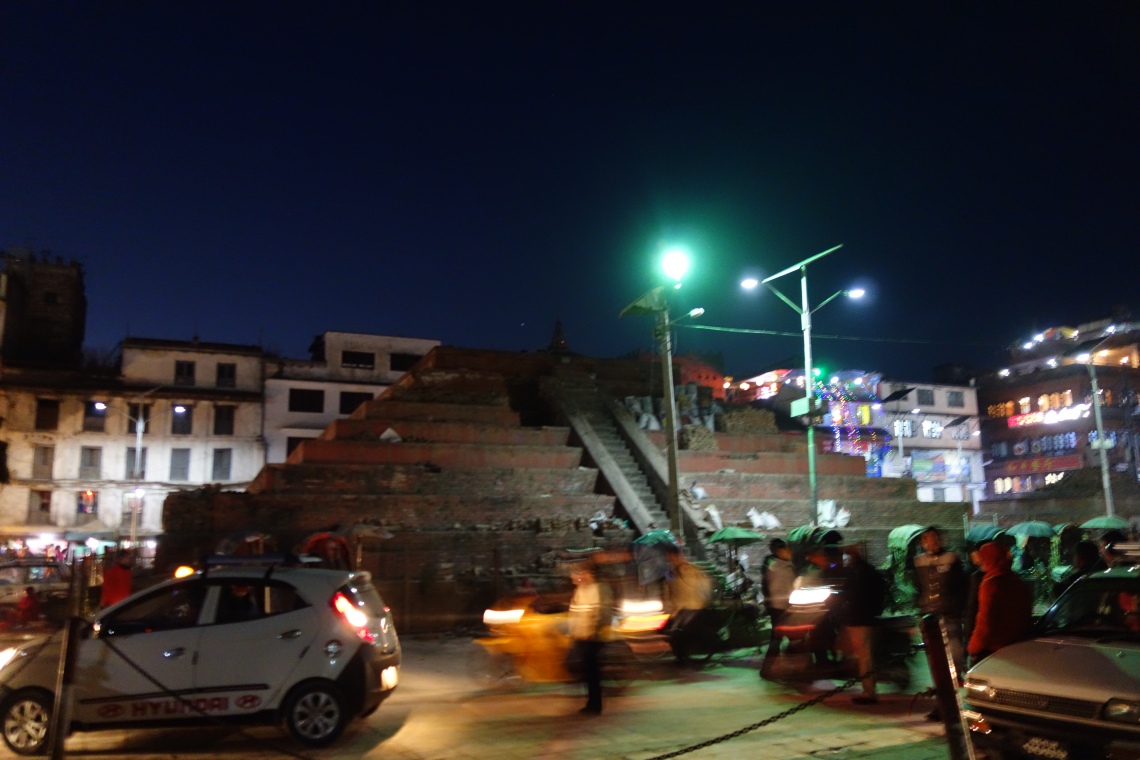
That atmosphere at night is incongruous with that of a royal court. Young people fill hipster chai cafes that resemble exclusive bars and commuters make pit stops at candle-lit shrines. Traffic flows through the square, bringing a cacophony or horns and engines into the otherwise serene abode.

But Durbar Square (meaning “Royal Palace Square”) is just a generic name. Each of the three city-states that once occupied the Kathmandu Valley had its own square. This means there are more squares, temples and palaces to explore!
An alternative—or rather a superior option altogether—to Durbar Square in Kathmandu is Durbar Square in Patan. Patan is a medieval Newari city-state on the other side of the Bagmati River which has since fused into Kathmandu proper thanks to both cities’ sprawl. Although still damaged, the buildings in Patan’s Durbar Square are in much better condition.
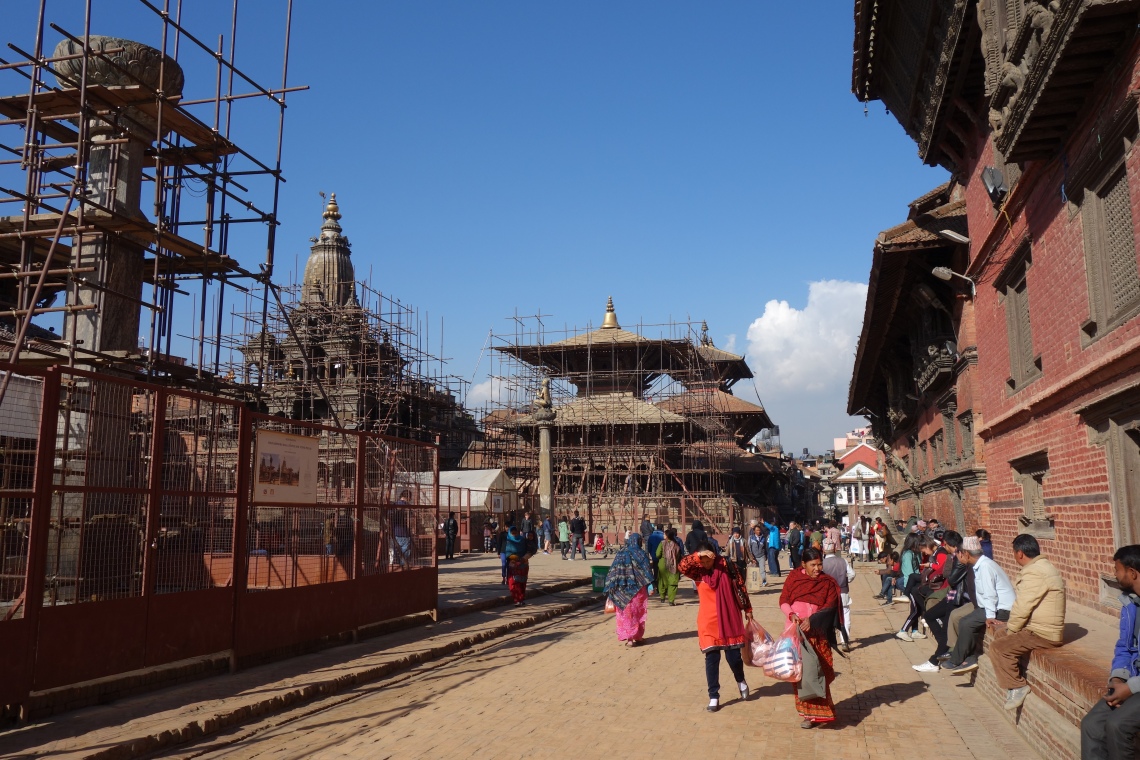
The intact royal palace also is beautiful to wander around. It also houses Patan Museum, one of the best in the country. The musuem’s extensive, period halls are filled with Hindu artworks and artifacts. The explanations are all excellent, and there are several displays discussing the significant of religious themes or demonstrating the crafting techniques. I love museums and this was still one of the best I’ve ever visited in the world.
The ace up Patan’s sleeve is that the surrounding districts are all of the same era and architectural style–straight out of the 17th century. The quiet, non-touristy laneways are probably the best places to explore on foot in the Kathmandu area. It’s so easy to lose yourself in the maze or intricate wooden facades and shimmery copper workshops. You’ll pass a bunch of shrines and markets along the way, which just add to the atmosphere.
One of the struggles of Kathmandu is finding local cruising from non-touristy joints. The backstreets of Patan were the perfect place to alleviate my longing. Momos are a kind of Tibetan dumpling synonymous with the refugee population throughout Nepal. They’ve also long been associated with the Newari community of the Kathmandu valley, and are somewhat of a national dish.
Like most dumplings, momos can be steamed or fried but the steamed variety is more common. Buffalo mince is the typical filling but you can also find chicken or vegetarian momos too.

If Patan somehow wasn’t enough for you, the third former Newari city-state of Bhaktapur is just a short drive away. The old town is much larger than even Patan, encompassing several squares. Some sections of Bhaktapur escaped the earthquake relatively unscathed, but the royal palace there and its surrounds were unfortunately decimated.
Situated on a trans-Himalayan trade route since time immemorial, the town’s history is one of prosperity and colliding cultures. It’s much more touristy than Patan or the Durbar Square in Kathmandu proper, and you’ll have to pay an entrance fee to merely enter the old town. But this is just a testament to how uniformly preserved the labyrinth of laneways and squares of Bhaktapur is—rather than being home to attractions, the town is the attraction.

That’s not to say there are no sights! Following the main road eventually takes you to the Nyatapola Temple. This 5-storey pagoda is the tallest in the country, and one of the tallest buildings in general in the Kathmandu Valley. Built in 1702, it surprisingly withstood earthquakes in 1934 and 2015 when most others didn’t.
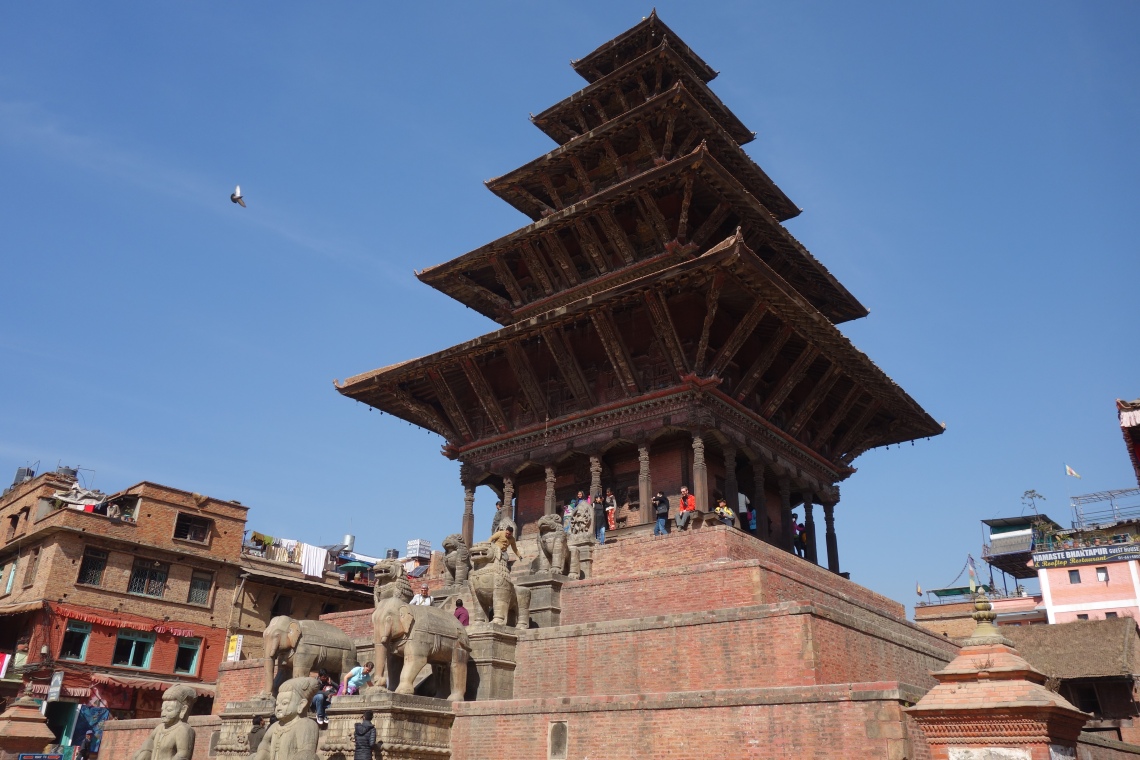
Climbing up the steps gives a great view of the rooftops and adjacent square. Down below there are smaller temples and shrines which are well-patronised by worshippers. The architecture of the temple—and the rest of Bhaktapur—is beautiful and intricate. But what sets this temple apart in particular is its form factor. Being a pyramid on top of a pyramid, this precursor to a skyscraper is the best example of a style that is unlike anywhere else in the world. It seemingly defies gravity, while the wood carvings and masonry remind you how old the structure really is.


Further into the heart of Bhaktapur is its own Durbar Square. Like in Kathmandu proper, much of the temples are in complete ruin. The palaces fared slightly better, but many are still under heavy restoration. It’s best to keep wandering, as there are several smaller squares around Bhaktapur each with its own metalwork, woodwork or pottery on display.
While fairly touristy, Bhaktapur is still a decent place to explore Nepali cuisine. Samay baji is a traditional Newari dish reserved for special occasions. But thanks to the advent of tourism it’s now available throughout the old town of Bhaktapur. The assortment includes buffalo meat, egg, potato, greens, ginger, and practically whatever else is available at the time. The centrepiece is a mound of beaten rice. It’s not only delicious in its own right but is a very welcome respite from weeks of dal bhaat and momos.
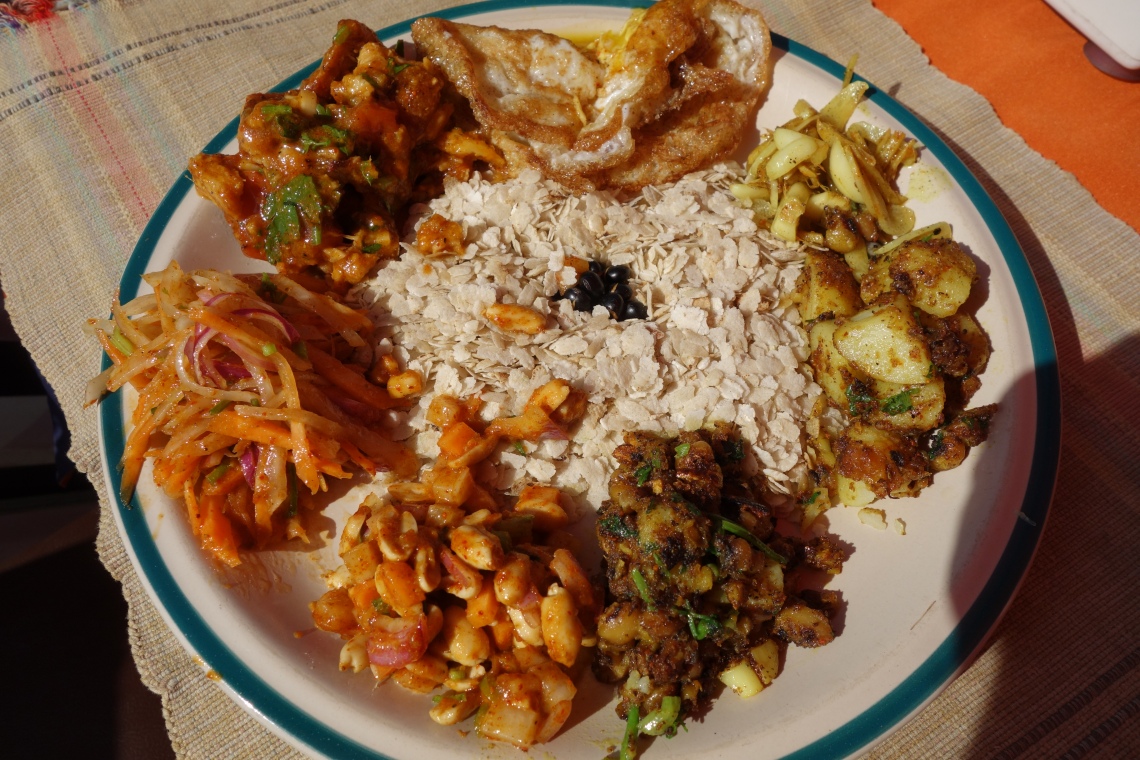
It’s so easy to rank Kathmandu’s districts by how damaged they were in the earthquake. But the reality is that the amount of damage corresponds to the amount of casualties. Yes, some tourist attractions are now gone, but the people who lived there were also killed.
On top of this, Kathmandu still has yet to fully recover. Many districts still have buildings propped up by wooden supports. It’s an impractical and possibly dangerous solution, but it’s only out of necessity to keep people’s homes and businesses structurally sound. Tourism can potentially a source of income to recover from this situation, but for it to be somewhat equitable it’s important to remember the human beings whose neighborhoods you’re visiting.
Many of the sights in Kathmandu might seem relatively repetitive. Palaces, temples and stupas all start to look the same after a while. But each of these is so deeply woven in to the city’s fabric that the only way to experience them is as parts of a greater whole. There are vibrant cultures to be witnessed and rich histories to learn about. No matter which Durbar Square you visit, you’ll want to see another. Repeat visits to sights will never gpet old. The attraction here is the city itself, and the sights are inseparable from that.
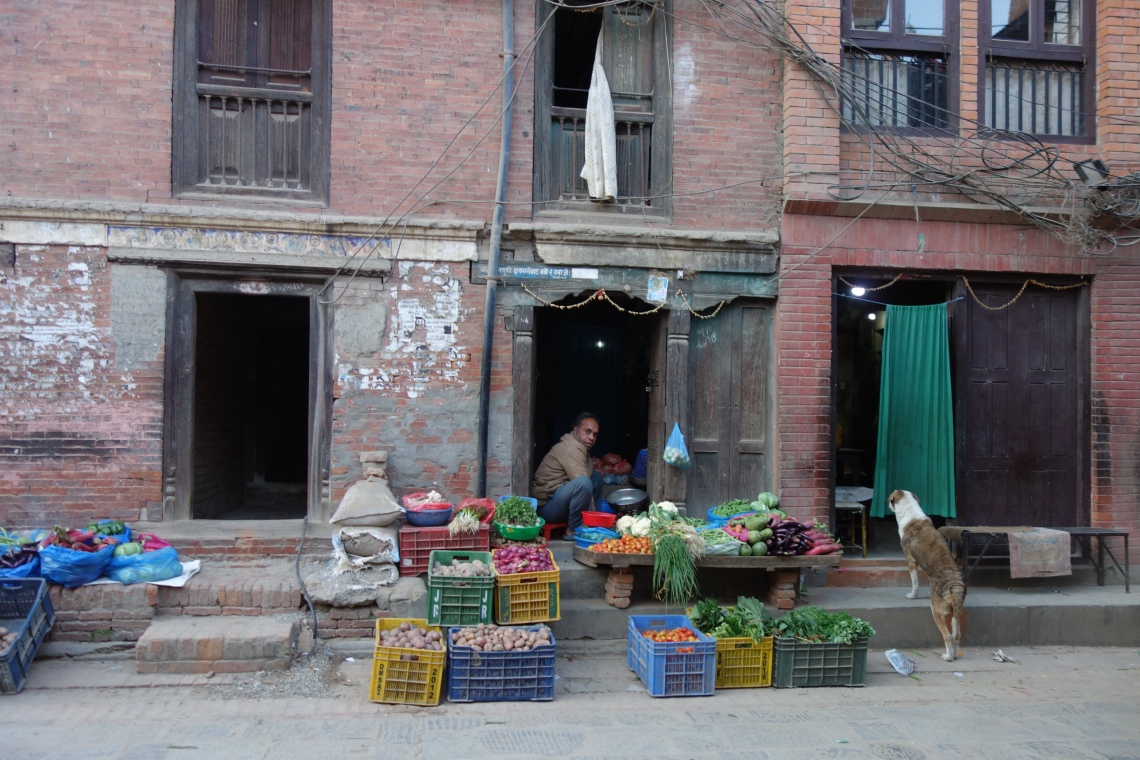


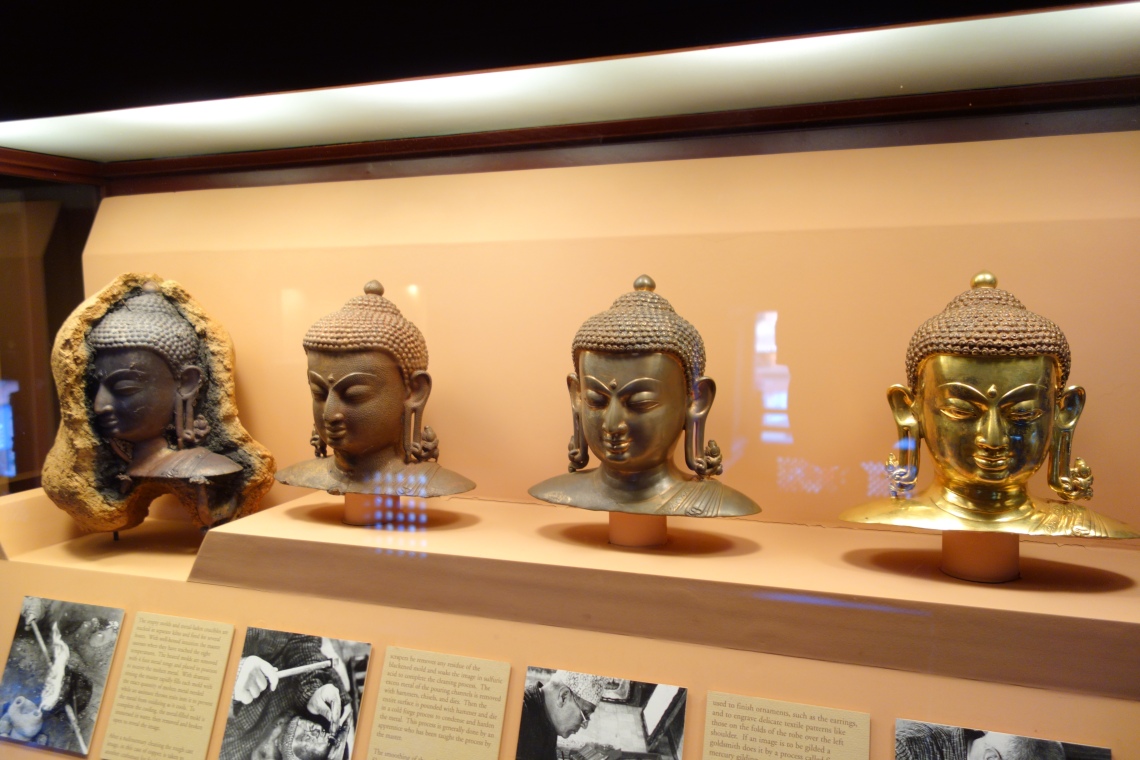
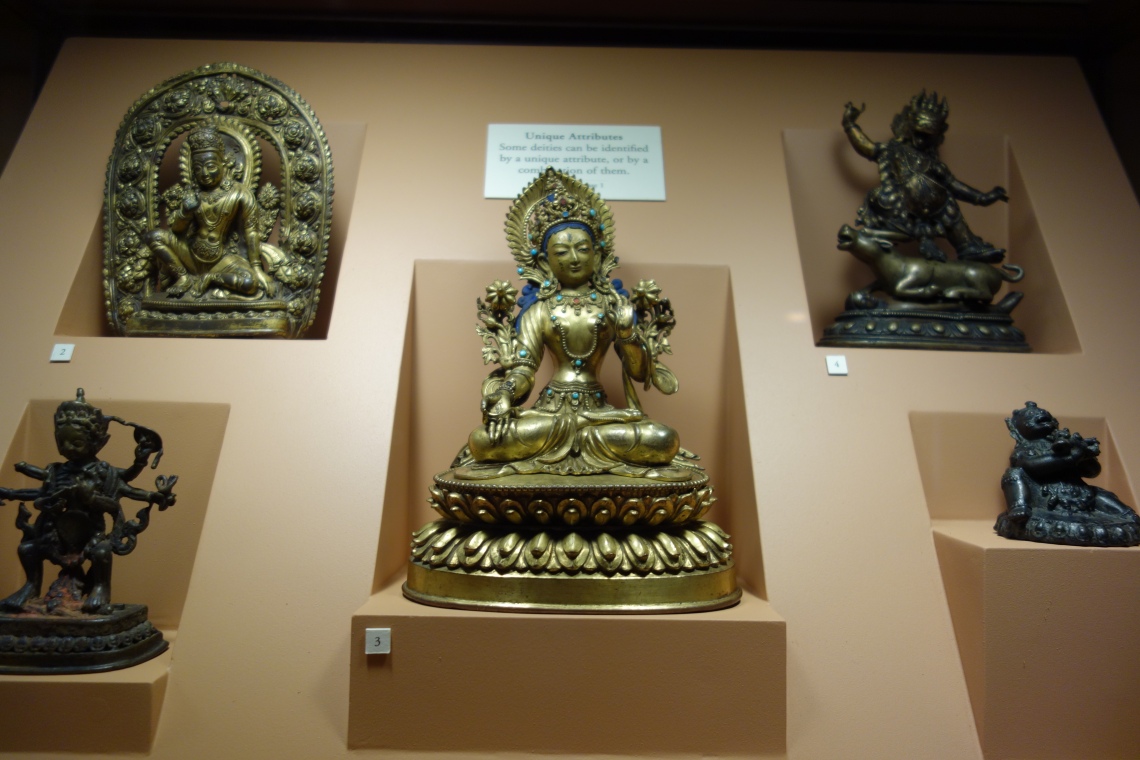



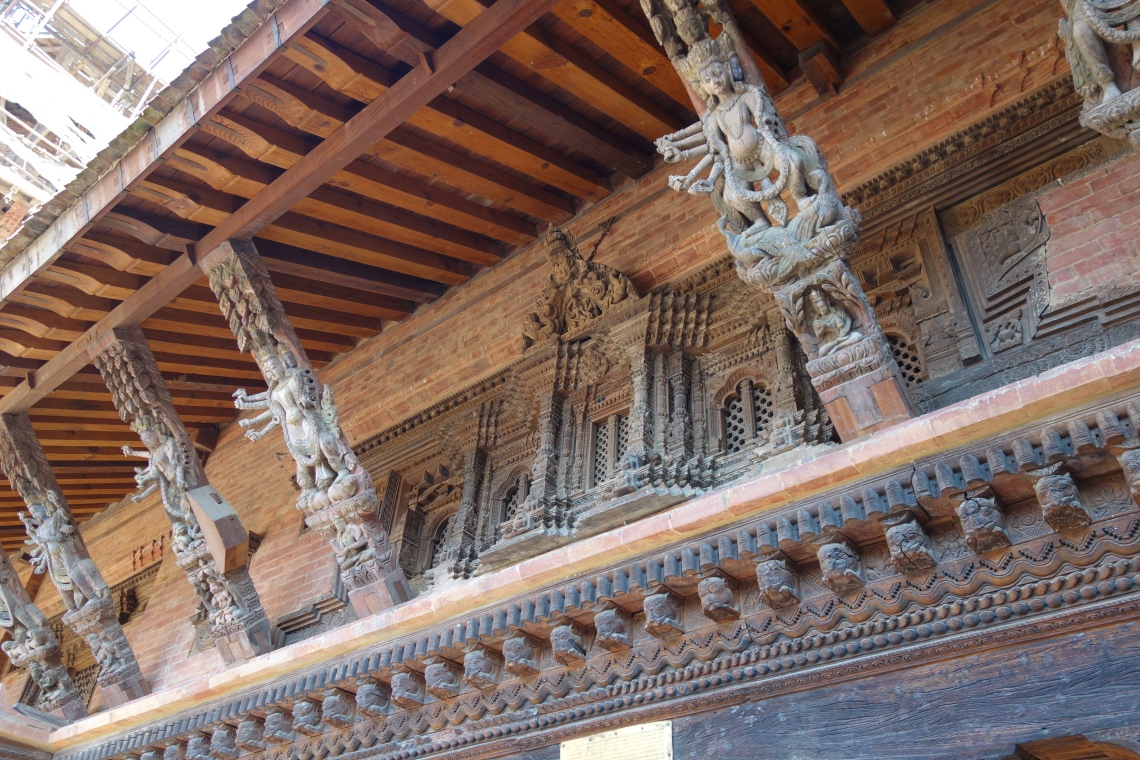

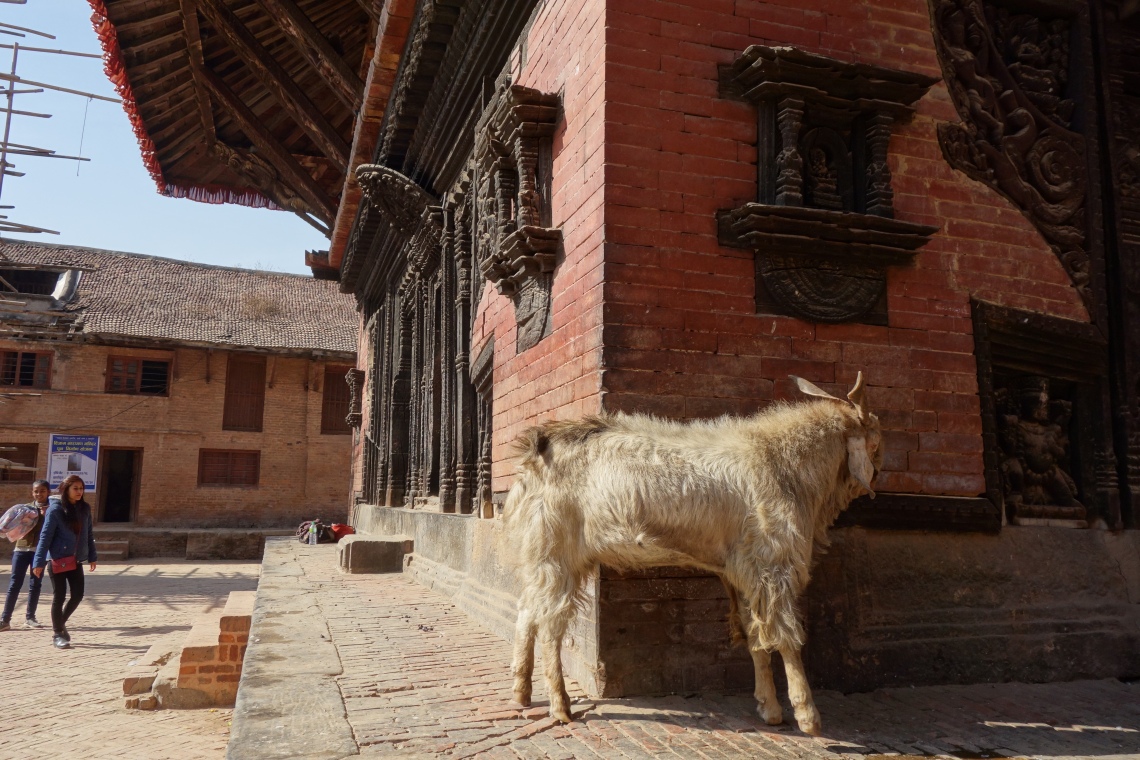



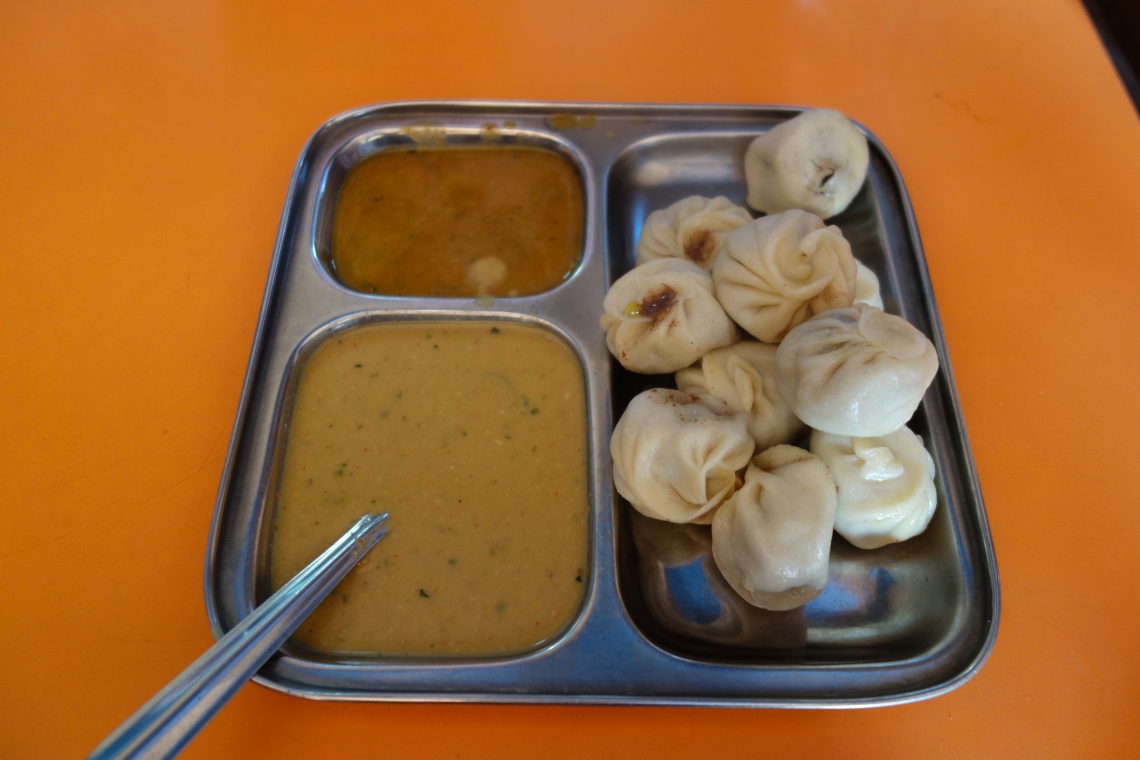


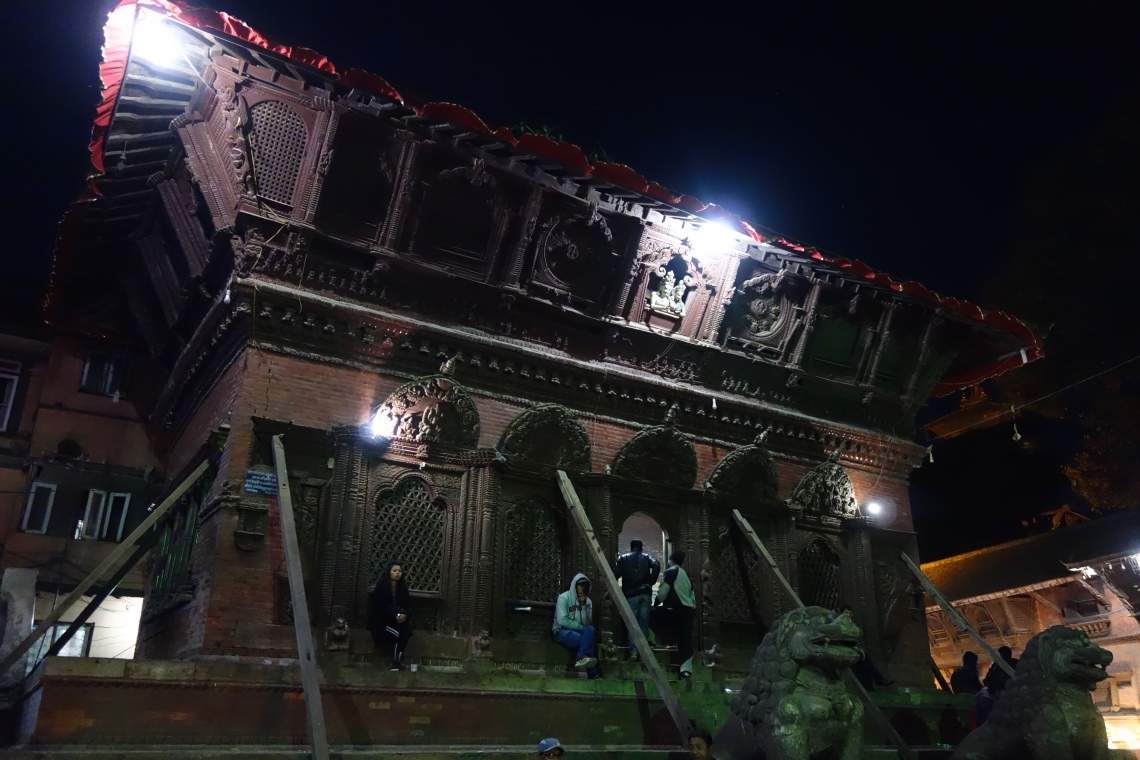

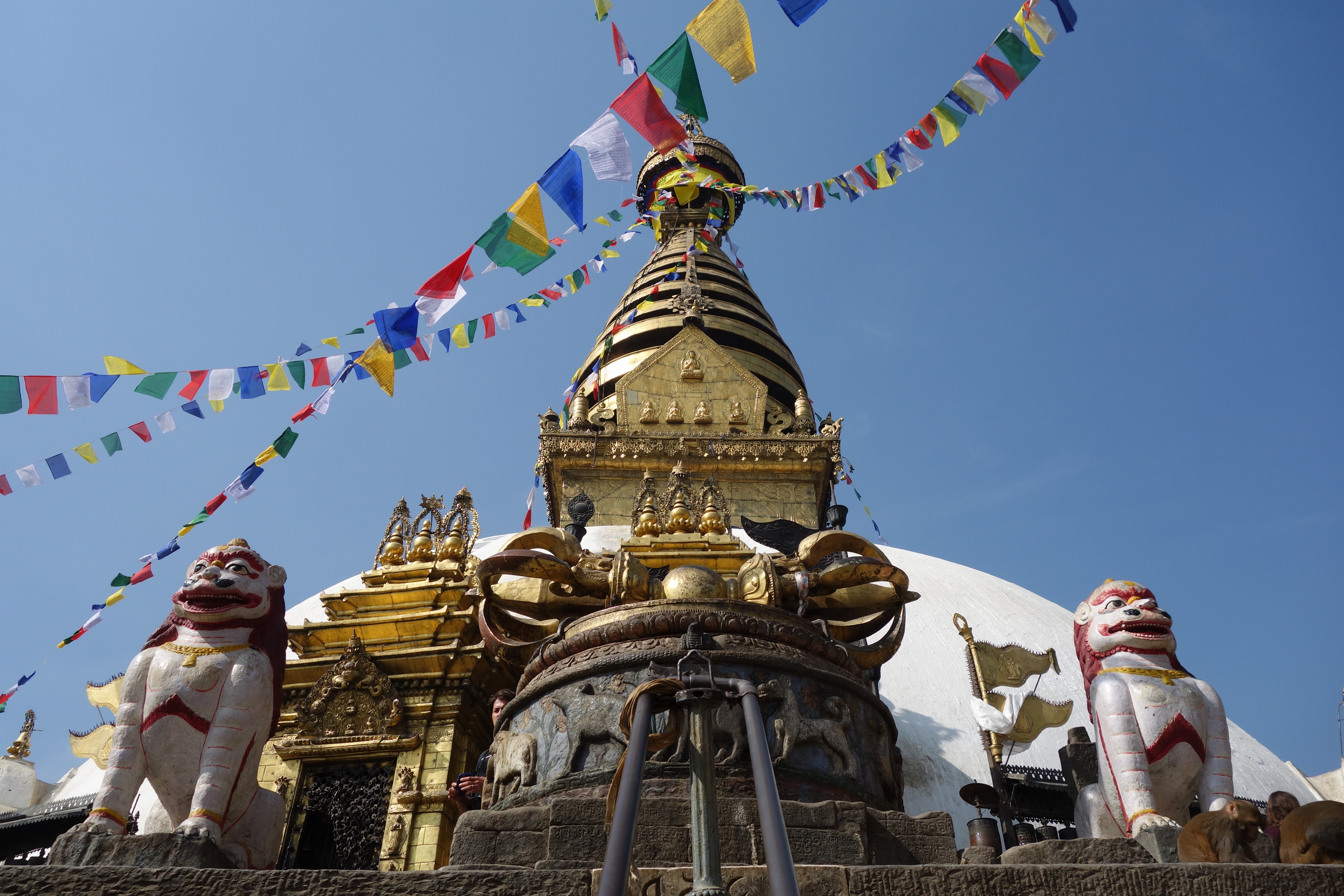














The culture, architecture and food you have featured are all breathtaking. I would love to see this in person and of course taste those momos for myself.
The peaceful cohabitation of two religions is something other religions and cities could learn from. But I guess when you live on top of the world it is easy to rise above your petty differences.
I really love the manuscript (Buddha Plan) you found in that museum. I do a lot of drafting in my day job, as do many of my friends. To see an ancient technical drawing, that is essentially an instruction manual for building a gilded Buddha is pretty awesome!
Thanks for sharing. Keep travel blogging. Adventure is better shared with friends!
LikeLike
Thanks so much Anthony!!
So glad you liked the Buddha plan! I spent way too long gazing over all of the manuscripts in the museum. Not only are they beautiful but I found they give excellent insight into the history and culture of the area. Seeing the finished products only solidified this.
Although there were some forced deportations of Theravada Buddhist monks in the first half of the 20th century, nowadays different people’s religious practices seem to overlap with one another which I found really beautiful.
LikeLike
I think this is the first blog post I’ve seen about Kathmandu that actually gives me a real feel for the place, and an understanding of what my experience would be like if I were to visit. It’s really good to know that even the busiest touristed places are not overly touristy in feel, and still retain a lot of charm. I’m loving the photographs too!
LikeLike
Cheers Kavita! Kathmandu is definitely an example of how to manage mass tourism without corrupting the area.
LikeLike
I agree with you about Thamel. Despite being very touristy, I never felt uncomfortable walking around its streets and alleys. As for Patan Museum, I was pleasantly surprised to see how well the museum was run. I remember learning a lot about the history of Vedic gods and goddesses before the Hindu Trimurti took over. The Kathmandu Valley is among the most fascinating and intriguing places I have ever visited in the world. From the exquisitely carved Newari buildings to the labyrinthine streets of Old Kathmandu — one street in Asan Tole was the very street erstwhile traders walked, carrying goods to and from India and Tibet — it was a magical, chaotic place.
On a side note, I think you had that samay baji at the same restaurant where I went. I recognize the plate and the table runner: https://harindabama.com/2017/05/06/here-come-the-europeans/05-04-02/
LikeLike
Ahahahah no way, that’s crazy that we had the exact same meal! At the restaurant overlooking the Nyatapola Temple right? But yeah, couldn’t have said it better myself Bama. There is so much to see around Kathmandu which makes the city so magical. I also learned a lot at the Patan Museum, particularly about the symbolism of different deities’ poses and hand gestures which I had previously disregarded.
LikeLike
Actually my friend and I stayed two floors below the restaurant — one morning as we headed upstairs I saw the intricate carvings of Nyatapola glowed in the morning sun. Such a breathtaking sight, really!
LikeLike
Ahhh staying in the heart of old Bhaktapur sounds incredible! Must’ve been so nice in the mornings and evenings when most other visitors have left.
LikeLike
One of the best posts I have read on Kathmandu in a while! Your photos and descriptions, as well as your way of pointing out the challenges of recovery and the need for tourism are fantastic. Especially loved this “Palaces, temples and stupas all start to look the same after a while. But each of these is so deeply woven in to the city’s fabric that the only way to experience them is as parts of a greater whole.” Spot on!
LikeLike
Thanks a lot Michael! Although the Nepali tourist trail is once again ‘open for business’, recovery is still ongoing so I found it important to be conscious of that.
LikeLike
The signs of the 2015 earthquake are still all over this magnificent city. I was in Kathmandu in 2003 for a conference and took a helicopter tour around the Himalayas. I miss Durbar Square!
LikeLike
I can only imagine how magnificent the square was back then!
LikeLike
The blog beautifully depicts the life – the street scenes, the momos, the shrine everything. The coexistence of Hinduism and Buddhism is beautifully shown in that picture. Your writing makes me look at Kathmandu with a different perspective. Thank you for sharing!
LikeLike
Thanks so much, glad you enjoyed 🙂
LikeLike
This post had made me nostalgic of my first solo trip abroad in Nepal back in 2014, a year before the big earthquake. It’s sad to see how some of the temples/structures built centuries ago are now laying in ruins. Also glad to know that the Nepalese in Kathmandu had recovered from the disaster somehow….And those momos! I miss them too.:-)
LikeLike
You’re so lucky to have experienced the city just before the destruction! But thankfully the people and culture (and yes, the momos too haha) have survived the trauma.
Also, awesome choice for a first solo trip!!
LikeLike
Wow such a detailed and great description of everything here in Kathmandu! Very interesting how they cremate their loved ones in the open air as you said. Definitely something most would not be used to but I can appreciate the tradition and respect towards it. Those momo’s look delicious, along with all the other food! Hopefully the town can recover sooner than later with the help of extra tourism. Loved that you touched on both sides of the area, both good and bad. Thanks for sharing!
LikeLike
Cheers! There’s definitely plenty of things to experience, most of which are pretty unique. And if tourism can potentially aid recovery, then I think it’s well-worth being conscious of when visiting.
LikeLike
Kathmandu and the sourounding towns you mentioned look so beautiful. I am glad you wrote about the earthquakes and what and who was lost. As westerners we often forget that much of the world is not as resilient to devastation. I also love that you won’t find people haggling to sell you things in these towns. Sounds perfect
LikeLike
Thanks! The balance between touristy and harassment really is perfect in Kathmandu. Everyone is willing and prepared to sell you whatever you need, but there’s never any pressure to buy either.
LikeLike
This place looks so amazing I know I must explore Kathmandu and see culture and history first hand. Thanks for this well put together post!
LikeLike
Thanks Samantha!
LikeLike
We visited Kathmandu while I was still a child and I remember a few things about it…especially that it is very rich in history and heritage. It was interesting to see the pictures of the artefacts displayed in Patan museum. Would love to spend a couple of hours exploring the collection it has.
LikeLike
It’s definitely one of those museums you can spend hours in and lose track of time. And I must say you’re pretty lucky to have visited so young, even if you don’t remember much hahaha
LikeLiked by 1 person
I can see why it’s entirely a UNESCO World Heritage Site, wow. That delicious looking street food is making me hungry. I’d kill for a steamed momo right now!
LikeLike
You’re so right Carmen!
LikeLike
I’ve never been to Kathmandu but it’s always interested me, the name has a nice ring to it. The mix of ghoulish, almost pagan-like traditions with the children playing is such an interesting thing to hear; I never knew Nepal embraced mortality as extensively as it did. It’s also so good to see that tourists are still contributing to the Nepalese economy despite the earthquake even though the remnants are still very present. Such a unique post, thanks for sharing!
LikeLike
Cheers Elijah, it was quite surreal yet beautiful to see deaths mourned so publicly.
LikeLike
A wonderful blog – thank you so much for sharing. I’m in the midst of planning a couple of weeks exploring Kathmandu and the valley (alas, a recurring knee injury means only limited trekking) but I figure that just means more time exploring the cultural sights and soaking up the region. By the way, was it easy to get off the beaten path and away from the tourist crowds? From your comments, it seems that just a few minutes wandering away from the main sights it was quite quiet and beautiful.
Many thanks again, I’ll be referring to your thoughts as I continue to plan!
LikeLike
Thanks so much Simon!
There definitely are plenty of cultural sights (most of which are somewhat overlooked by visitors) to last a whole trip. Tourists do tend to crowd around the main attractions, and rightfully so, but as you say walking a few blocks in the other direction will give you the same culture, cuisine and architecture but with only locals in sight. It’s a much more authentic experience IMO. It may be a bit harder to hail a taxi but the amazing food will more than make up for that haha. My favourite spot to wander away from the tourist attractions was Patan, but most of the Kathmandu valley is good for exploring on foot.
Also regarding trekking it’s apparently quite cheap and easy to get a porter which may alleviate some of the difficulty of a leg injury. I’ll have a post touching on trekking with an injury (albeit without a porter or guide) when I can next get to a computer. Obviously everyone’s injuries and desires are different, but it’s definitely not impossible to do if you’re afraid of missing out!
LikeLike
Cheers Zac. Yeah, I’m really looking forward to it. I will be heading there in late September (so the end of the monsoon) which might make a trekking decision rather defunct – battling muddy paths with this knee is really not a good idea – but I’ll keep my options open and might try a squeeze a smaller one in. And I’ll definitely look into the porter idea. If worse comes to worse, I’ll just have to splash out on a Everest scenic flight, and although it won’t be as special as a great hike, it’ll certainly be better than nothing. First world problems eh?
Can I ask another question, although I’m not sure how much of Nepal you’ve checked out yourself…
I’m only going to be able to go for two weeks (I’m a teacher and it’s school holidays here in Melbourne) and I’ll be arriving right at the start of the Indra Jatra festival which goes on for eight days and seems a pretty big deal in Kathmandu and has got me really excited (I do lots of photography, some lovely shots on your blog too!)
I am thinking of at least a week exploring the city and the surrounds (Patan, Bhaktapur and hopefully further into the valley). In your opinion, is it worth heading to Pokhara? I’ve had some mixed reports but I have heard that it is beautiful. But if I’m not doing any major trekking (and with the possibility of landslides and delays) and the likelihood of limited views of the mountains due to the monsoon lingering, would my time be better spent going a bit deeper into these areas and some other less visited spots in the Kathmandu Valley, and possibly doing a shorter hike around the rim? Having a chance to check out the temples, the culture and just everyday life is what I really enjoy, but then I’m also aware that in two weeks , I should probably head a bit further afield…
Anyway, as I said, any advice would be greatly appreciated!
BTW, I noticed you’ve just got back from Iran. I was backpacking with my wife for five months around there, Syria and Jordan about ten years ago. Still one of my favourite places on the planet. Looking forward to hearing about your adventure…
LikeLike
Hey Simon so sorry for this extremely late reply!! I’ve been hitching around Europe without a SIM so I’ve missed pretty much all of my notifications haha.
I can definitely relate to your first world problems haha. Having sunk costs and time into a trip I’m always a bit worried if I’m making the right decisions in advance!
A week probably isn’t enough for most treks (AC is 2-3 weeks for most people I think) but you can easily supplement certain legs of the trek with a bus ride or jeep, the latter being in the more mountainous parts. These are local transport options so they’re not too expensive and they run pretty much everywhere. If I had to pick a section of the AC it’s definitely be the part between Chame and Manang, which IMO had the most beautiful scenery and most interesting culture.
Also the Indra Jatra festival looks incredible, can’t believe I’ve never heard of it!
Pokhara is a really nice town… to recover from a trek. The lake is nice but the town itself is nothing special in terms of culture or nature. It’s extremely touristy, even compared to SEA, and the main strip is bars, clubs and souvineer shops. I really enjoyed Pokhara but only because my legs were dead from trekking and I was craving food and nightlife. I wouldn’t recommend it as a destination in itself, and I’ll hopefully touch on this when I get to a computer.
I didn’t really head anywhere else in the country so I can’t give any recommendations unfortunately.
And yeah, I feel the same way about Iran and it’s people!! Thanks for the support!
I’m on a mobile so let me know if I’ve forgotten to answer anything haha
LikeLike
Sorry mate, meant to message you instead of replying to the post!
LikeLike